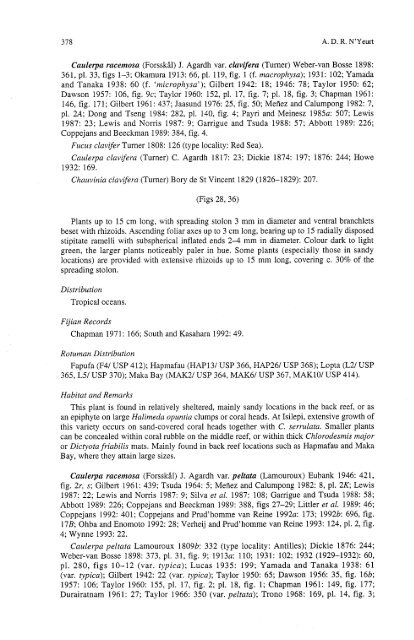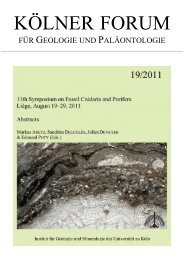Download (6Mb) - USP Electronic Research Repository - The ...
Download (6Mb) - USP Electronic Research Repository - The ...
Download (6Mb) - USP Electronic Research Repository - The ...
You also want an ePaper? Increase the reach of your titles
YUMPU automatically turns print PDFs into web optimized ePapers that Google loves.
Caulerpa racemosa (Forsskil) J. Agardh var. clavifera (Turner) Weber-van Bosse 1898:<br />
361, pl. 33, figs 1-3; Okamura 1913: 66, pl. 119, fig. 1 (f. macrophysa); 1931: 102; Yamada<br />
and Tanaka 1938: 60 (f. 'microphysa'); Gilbert 1942: 18; 1946: 78; Taylor 1950: 62;<br />
Dawson 1957: 106, fig. 9c; Taylor 1960: 152, pl. 17, fig. 7; pl. 18, fig. 3; Chapman 1961:<br />
146, fig. 171; Gilbert 1961: 437; Jaasund 1976: 25, fig. 50; Meiiez and Calumpong 1982: 7,<br />
pl. 2A; Dong and Tseng 1984: 282, pl. 140, fig. 4; Payri and Meinesz 1985a: 507; Lewis<br />
1987: 23; Lewis and Norris 1987: 9; Garrigue and Tsuda 1988: 57; Abbott 1989: 226;<br />
Coppejans and Beeckman 1989: 384, fig. 4.<br />
Fucus clavifer Turner 1808: 126 (type locality: Red Sea).<br />
Caulerpa clavifera (Turner) C. Agardh 1817: 23; Dickie 1874: 197; 1876: 244; Howe<br />
1932: 169.<br />
Chauvinia clavifera (Turner) Bory de St Vincent 1829 (1826-1829): 207.<br />
(Figs 28,36)<br />
Plants up to 15 cm long, with spreading stolon 3 mm in diameter and ventral branchlets<br />
beset with rhizoids. Ascending foliar axes up to 3 cm long, bearing up to 15 radially disposed<br />
stipitate ramelli with subspherical inflated ends 2-4 mm in diameter. Colour dark to light<br />
green, the larger plants noticeably paler in hue. Some plants (especially those in sandy<br />
locations) are provided with extensive rhizoids up to 15 mm long, covering c. 30% of the<br />
spreading stolon.<br />
Distribution<br />
Tropical oceans.<br />
Fijian Records<br />
Chapman 1971: 166; South and Kasahara 1992: 49.<br />
Rotuman Distribution<br />
Fapufa (F41 <strong>USP</strong> 412); Hapmafau (HAP131 <strong>USP</strong> 366, HAP261 <strong>USP</strong> 368); Lopta (L21 <strong>USP</strong><br />
365, L51 <strong>USP</strong> 370); Maka Bay (MAK21 <strong>USP</strong> 364, MAK61 <strong>USP</strong> 367, MAK101 <strong>USP</strong> 414).<br />
Habitat and Remarks<br />
This plant is found in relatively sheltered, mainly sandy locations in the back reef, or as<br />
an epiphyte on large Halimeda opuntia clumps or coral heads. At Isilepi, extensive growth of<br />
this variety occurs on sand-covered coral heads together with C. serrulata. Smaller plants<br />
can be concealed within coral rubble on the middle reef, or within thick Chlorodesmis major<br />
or Dictyota friabilis mats. Mainly found in back reef locations such as Hapmafau and Maka<br />
Bay, where they attain large sizes.<br />
Caulerpa racemosa (Forsskil) J. Agardh var. peltata (Lamouroux) Eubank 1946: 42 1,<br />
fig. 2r, s; Gilbert 1961: 439; Tsuda 1964: 5; Meiiez and Calumpong 1982: 8, pl. 2K, Lewis<br />
1987: 22; Lewis and Norris 1987: 9; Silva et al. 1987: 108; Garrigue and Tsuda 1988: 58;<br />
Abbott 1989: 226; Coppejans and Beeckman 1989: 388, figs 27-29; Littler et al. 1989: 46;<br />
Coppejans 1992: 401; Coppejans and Prud'homme van Reine 1992a: 173; 1992b: 696, fig.<br />
17B; Ohba and Enomoto 1992: 28; Verheij and Prud'homme van Reine 1993: 124, pl. 2, fig.<br />
4; Wynne 1993: 22.<br />
Caulerpa peltata Lamouroux 1809b: 332 (type locality: Antilles); Dickie 1876: 244;<br />
Weber-van Bosse 1898: 373, pl. 31, fig. 9; 1913a: 110; 1931: 102; 1932 (1929-1932): 60,<br />
pl. 280, figs 10-12 (var. typica); Lucas 1935: 199; Yamada and Tanaka 1938: 61<br />
(var. typica); Gilbert 1942: 22 (var. typica); Taylor 1950: 65; Dawson 1956: 35, fig. 16b;<br />
1957: 106; Taylor 1960: 155, pl. 17, fig. 2; pl. 18, fig. 1; Chapman 1961: 149, fig. 177;<br />
Durairatnam 1961: 27; Taylor 1966: 350 (var. peltata); Trono 1968: 169, pl. 14, fig. 3;

















